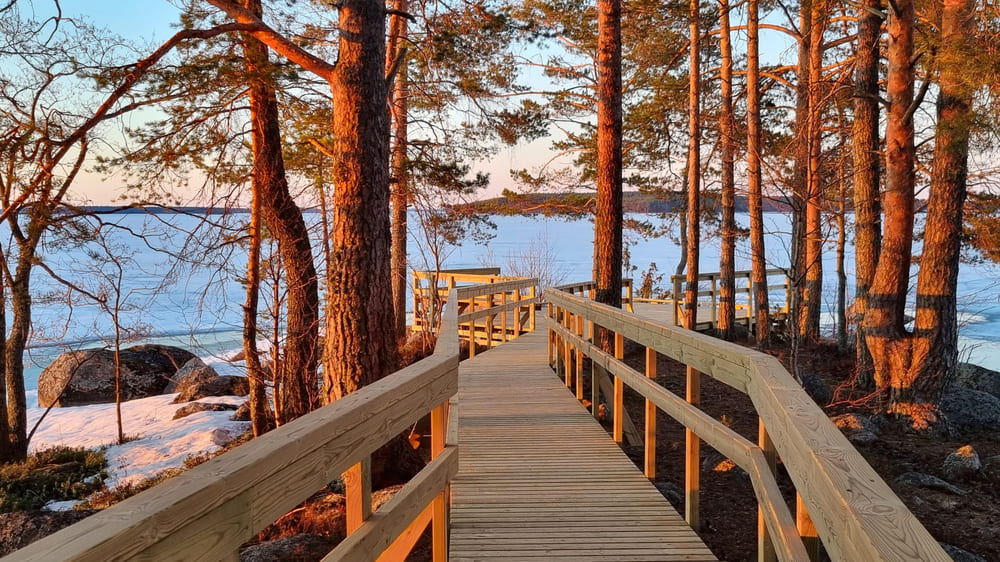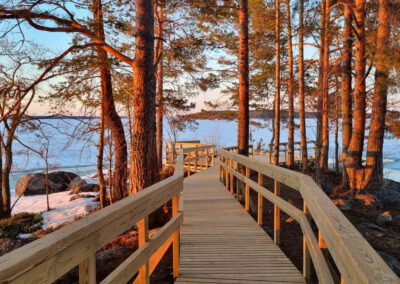Basic info
Country:
Area:
Population:
Density:
Summary:
References:
Keywords
Gallery
Sustainable recreational space that protects natural values while enriching the visitor experience.
Issues Addressed
The Sarviniemi project tackled multiple challenges simultaneously. Primarily, it aimed to develop the area as a sustainable and high-quality recreational space that could cater to both local users and tourists. The South Karelia’s Recreation Area Foundation recognized the delicate balance required to raise interest in Sarviniemi’s magnificent landscape while protecting it from human-induced erosion. A key concern was the preservation of the sensitive sandy till beach, which was showing signs of wear due to increased foot traffic. The project also sought to address the lack of proper infrastructure that could support sustainable tourism growth without compromising the area’s natural integrity.
Approaches and Solutions
South Karelia’s Recreation Area Foundation adopted a holistic and innovative approach to address these challenges. Collaboration was at the heart of their strategy, with the foundation partnering with Aalto University’s Architectural Department to develop comprehensive landscaping and architectural plans. This partnership brought fresh perspectives and cutting-edge design solutions to the project as two Master’s theses were produced as part of the project. One of the key strategies employed was the concentration of high-traffic activities near the sandy beach area. This approach aimed to minimize environmental impact by containing visitor movement to designated areas, thereby protecting more sensitive ecosystems from excessive disturbance. The architectural designs for new buildings were carefully crafted to blend seamlessly with the landscape. This not only preserved the area’s natural aesthetic but also minimized the visual impact of human intervention. The designs incorporated sustainable materials and energy-efficient systems, setting a standard for eco-friendly construction in rural tourism development. A significant focus of the project was on raising awareness about Sarviniemi’s geological and historical significance. Educational elements were integrated into the landscape design, providing visitors with informative experiences that fostered a deeper appreciation for the area’s natural heritage.
Actors and Stakeholders
The success of the Sarviniemi project hinged on the effective collaboration of various stakeholders. The South Karelian Foundation for Recreation Areas played a crucial role in providing expertise on sustainable recreational area management and leading the initiative, coordinating efforts and ensuring alignment with local development goals with the help of Taipalsaari municipality. Aalto University’s involvement brought academic rigor and innovative design thinking to the project. Two students doing their Master’s thesis on the design of Sarviniemi and faculty from the Architectural Department contributed fresh ideas and sustainable design solutions, bridging the gap between theoretical knowledge and practical application. Local residents were also key stakeholders, providing valuable insights into the area’s usage and cultural significance. Their involvement ensured that the development plans respected local traditions and met community needs.
Challenges and Opportunities
The project faced several challenges, including the need to balance increased tourism with environmental conservation. The sensitive sandy till beach required special attention to prevent further erosion. Additionally, securing funding for long-term development and maintenance posed a significant challenge. However, these challenges also presented opportunities. The project allowed for the implementation of innovative sustainable tourism practices that could serve as a model for other rural municipalities. It also provided an opportunity to educate visitors about the importance of geological heritage and sustainable tourism.
Outcomes and Lessons Learnt
The Sarviniemi project yielded significant positive outcomes. The completion of comprehensive landscaping and architectural plans laid a solid foundation for sustainable development. Initial visitor facilities were constructed, enhancing the area’s capacity to handle tourists while minimizing environmental impact.One of the most notable achievements was the successful mitigation of erosion issues around the sensitive sandy till beach. By strategically designing pathways and viewing areas, the project managed to protect this unique geological feature while still allowing visitors to appreciate its beauty. The project also succeeded in raising awareness about Sarviniemi’s geological and historical significance. Through carefully designed information points and educational trails, visitors now leave with a deeper understanding and appreciation of the area’s natural heritage. Perhaps the most valuable outcome was the establishment of a replicable model for sustainable rural tourism development.
The Sarviniemi project demonstrated how careful planning, stakeholder collaboration, and innovative design can preserve natural heritage while promoting responsible tourism. Key lessons learned include the importance of interdisciplinary collaboration, the value of integrating educational elements into landscape design, and the effectiveness of concentrating high-traffic activities to minimize overall environmental impact. As Sarviniemi continues to evolve as a sustainable tourism destination, it stands as a shining example of how rural municipalities can leverage their natural assets for economic development while ensuring their preservation for future generations. The project not only enhanced the local community’s recreational opportunities but also positioned Taipalsaari as a leader in sustainable rural tourism development, offering valuable insights for other European municipalities facing similar challenges.


